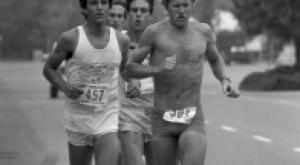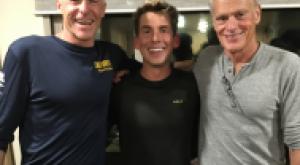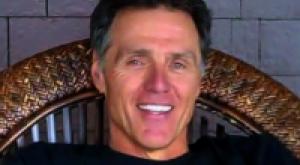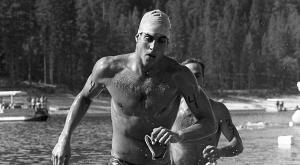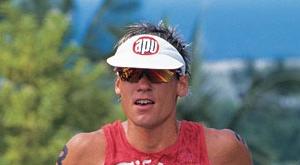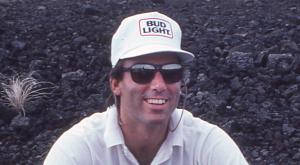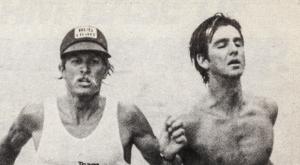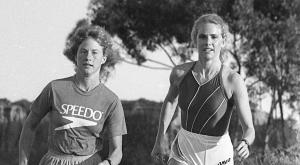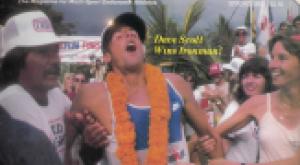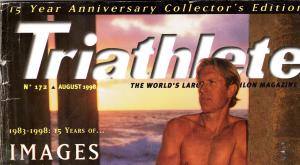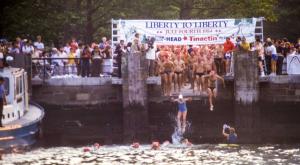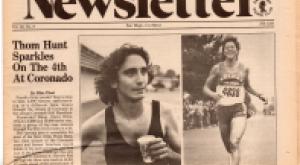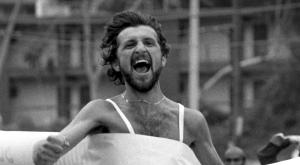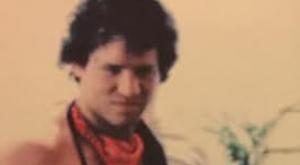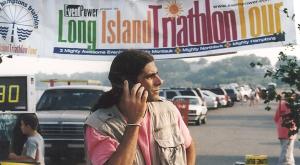
At the end of a regular college day in late spring, the threat of final exams and the promise of summer in the air, I opened the mail box. It was May 14 of 1979 and mixed with a utility bill and a “your rent is late again” note from the landlord was a copy of Sports Illustrated Magazine (SI). Hmmm, must belong to the neighbors. I don’t read about team sports. I pondered the mag until seeing the hand-written note clipped to the cover that featured a horse named Spectacular Bid. In typical SI cover-curse fashion, the equine athlete never reached his/her potential.
“Check out the story on that triathlon race in Hawaii I was telling you about. You might enjoy it.”
The hard scrabbled message was from my Pacific Beach neighbor and sometimes competitor in local running events, Tom Warren. I’d met Warren at the one of the two annual triathlons that were staged on San Diego’s Mission Bay between 1974 and 1979. The only reportage of those events was a short paragraph in the San Diego Track Club newsletter and the San Diego Running News. Results were passed around like tips on cheap happy hours prices, judiciously by the few dozen who swam and rode and ran in that circular place in history.
Warren was a fascinating case study of an early endurance athlete; part entrepreneur, part astronaut, part surf bum. He was to become the anti-mentor I never thought I needed and has taught me many things I will never need. I tossed the late rent notice on my roomies’ desk, opened a can of college beer and thumbed through the magazine article. And after 106 pages scattered with ads for whiskey, cigarettes, pens, and Pontiacs I landed on a two page spread simply and boldly titled, “Ironman.” Three colored images of Warren opened the 6175 words that would bleed across more than ten pages. I sat down on a second hand couch and read every one of the writer, Barry McDermott’s words. When I was done I noticed that my heart rate had risen and my beer was warm. So I read those words again. And nothing was ever the same.
Placing historical value on modern journalism is a risky business at best and better left to distill for a few decades until present day participants see the import of knowing which foundations scaffolded the course they compete upon. The periodical arena was much different in 1979 and for sports, Sports Illustrated Magazine held the top spot for sports reportage. To this day, sports media pundits are still wondering how McDermott, a golf writer for the magazine, was able to convince his editors to run 6175 words over 10 pages on a sport that wasn’t even a sport. The Ironman Triathlon was, according to anyone in sports media who’d heard the rumors, an obscure gathering of athletic freaks, a side show of suffering that might balance the increasingly instrumentalized world of organized professional leagues.
But something terribly mythic happened when McDermott, the golf writer from New York, followed Tom Warren, the underdog barkeep from Pacific Beach. The story of McDermott’s story is that he was taken by the absolute in Warren’s tenacity, his under-spoken quest for something deeply personal as it unfolded on the cusp of modern sport’s hyperbolic drama. McDermott appears conflicted as the well-prepared heir apparent and 1978 runner up, John Dunbar, arrives at the start of the event wearing a Superman costume. He writes eloquently of the defending champion, Gordon Haller, a former taxi driver who will not date a woman who smokes. But where the piece gains traction, hearts, and minds is where McDermott feels Warren’s ancient pain born of striving. It’s where McDermott the golf writer is so compelled by Warren’s deep struggle among better athletes, that he cannot help himself any longer. It’s where McDermott’s investigative journalism—time spent unraveling Warren’s broken past—comes right up against his and Warren’s imperfect present. And when it is apparent that the non-factor, Warren, will win the event, McDermott abandons his pen and pad and endeavors to run alongside Warren for the last few miles of the marathon.
The backstory of how McDermott came upon the event at all is of interest. Today, Sports Illustrated Magazine is power focused study in American sports’ standard faire. The basketball/baseball/football stories are engineered versions of each other targeting the under-educated 25-29 YO male. The magazine has little edge. But in 1979 the reporting was crisp and eclectic. CBS News’ Chief Investigative Journalist, Armen Keteyian, arrived at the magazine as a junior writer/reporter in 1982.
“We used to cover sports like archery and moose hunting.” Asked what the chances were then of a rollicking 10 page, 6175 word story on an underground event such as Ironman make the mag he suggested, “It’s not out of the realm of thinking that McDermott could’ve stumbled on a really good story, threw himself into the culture, and the editors just ran with it.”
Walter Bingham, an Editor at SI in the 70s and 80s, weighed in on the piece. “There’s no telling who edited Barry’s piece…chances are that they’re dead now.”
Regardless of the catalyst, journalistic poignancy of that singular article was not lost on readers of SI, inclusive of brass from ABC Television. No less than 90 days after the publication, ABC Sports executive, Bryce Weisman, was on the phone to Ironman Race Director, Valerie Silk about showcasing the 1980 event on ABC Wide World of Sports. McDermott’s piece on the Ironman and Warren was however, lost on Warren.
“A lot of people came into my bar after that story,” Warren recalls, “and most of them were just interested in seeing if I fit the profile.”
“How did you feel about the article,” I asked Warren. “Was it an accurate depiction of your intentions with the event at the time?”
“Well…(the dramatic pause goes on for nearly a minute), I never read the article carefully.” It’s at this point that a journalist/athlete must rely on instinct; I believed Tom because I had seen him function with integrity as an athlete, a bartender, and a body surfer, the three endeavors offering a glimpse into the man behind the thick lenses and thicker veneer. There was no reason to think that Tom Warren had not read the McDermott piece. It had no real bearing on his chosen path except perhaps a few more patrons wandered into his Tug’s Tavern for a week or two who would order a beer, shoot a game of pool, or hold themselves up against the now-distilling myth that Tom Warren—the Original Ironman--would become.
Some years ago I had spoken with McDermott and he was less sure of his contributions to the sport then. But he had not lost any feelings for the contribution of Warren. “To me,” I recall Barry saying, “Warren was this original Ironman. With nods to the 1978 winner, Gordon Haller, Warren was the first guy to make his own deeply personal mark on the event. And no one has done it in the same way since.”
In the summer of 2013 I found Barry McDermott selling real estate in Central Florida. I had to ask again.
“Hello, Mr. McDermott, this is Scott Tinley and you might not remember me but…” And after ten minutes of gushing I had my interview with the man whose hunch on what a sports story can be set slide a tectonic shift in endurance sports.
# # #
ST: Barry, can you talk about the conditions that led to your writing the piece in Sports Illustrated (SI) in May of 1979? Did you pitch it to the SI editors? Did you go to Oahu specifically to cover the event?
BM: Doing the story was my idea. I pitched an editor on it because I had read a rendition of the first race, the previous year, and felt that it was a compelling story for Sports Illustrated. I went to Oahu specifically to do the story. It developed over the years (falsely) that I was in Oahu because I was going to write about a golf tournament, but I had already switched my focus to the Ironman.
ST: In your SI piece of 5/14/79 you appear to question the sanity of the competitors offering such comments as “all finishers received five-inch-high trophies made of nuts and bolts, each with a hole in the top, or, you might say, the head,” and, “at the end he (John Dunbar in 1978) was staggering into parked cars and accusing his support-van driver of trying to poison him.” Yet with your characterization of the 1979 winner, Tom Warren, you offer periods of almost gushing support and admiration. Can you talk about the specific differences that you saw in the 1979 competitors?
BM: Sometimes, you will put a lot of effort into an article, and the editors will decide they don’t like it enough. But I knew I had a winner in the first Triathlon. I loved the name as well: Iron Man of Hawaii. As for the length of the article, I probably could have written a book. I loved the interplay between the “old” Tom Warren, and the other principals, the young tandem of John Dunbar and Gordon Haller. I had gone to a participant’s meeting leading up to the race, and sitting by himself, with sort of a glum look on his face, was Tom Warren. We started talking and it became apparent that he felt “ignored” by everyone. He thought the reason might be his age, but for whatever reason, others focused on Dunbar/Haller as the story. It seemed to me that Warren was out to the win the race, but even more focused on proving everyone wrong.
ST: Regarding key figures in your story, Gordon Haller and John Dunbar are positioned as both mutual foils but also set against the iconoclast, Warren. What are your interpretations overall of the competitors from that year?
BM: My feeling about the three protagonists’ roles then versus now is that I’m sure the same dynamics take place every year in the Ironman. As for a moment that, in my memory, will stay with me, I would say the fact they even had the race amazed me. The weather was horrendous. The race was delayed a day, because conditions were life threatening. Finally, the 30 participants who had shown up were given a choice: go now, and say your prayers.
ST: You appear to be pinning toward some kind of explanation of existential angst, positioning several figures in particular thematic locations: Warren as survivor, Dunbar as showman, Haller as journeyman, Cowman as child-like. For you, seeing this event in its infancy, were you struck with notions of immortality and resistance of fear?
BM: Out in the water, there were rescue paddlers waiting. Now when you see a young kid in Hawaii, wearing a wet suit and carrying a paddle board, you figure he knows his way around the surf. But one of the paddlers had to be rescued. He apologized. As for immortality and aging, I think the challenge is what propelled the participants, then and now. They all had an insatiable thirst that could not be satisfied.
ST: You capture Warren’s fascinating self like few—if any—others. What was it about him that struck you?
BM: What struck me about Warren was his complete focus on the prize. In my story, I wrote that a marathoner, who was a spectator, was so taken with Warren’s challenge that he jumped in alongside of him, and ran with him, trying to push him further. I did the same thing, later in the day. I would run about four-five miles with him, then rest in his support van. Then I would run another segment with him.
ST: The women’s winner, Lyn Lemaire, was in 2nd place for a period during the race yet you don’t seem to make a big deal in the piece. If you were to be writing the story now, would it matter that she was making a run at the lead?
BM: I probably should have known a bit more about the woman, Lyn Lemaire, or more specifically, written more about her. Keep in mind, however, that I well might have done the research for a book, but there was only so much space in the magazine, and certain things had to be left out.
ST: When you did your background work on Warren, was there anything that surprised you about his history? Or had you gained a sensibility for who he was by then? I know that you went to San Diego and spent time with him.
BM: In talking about being surprised by Warren, no one could be surprised by him, and everyone could be.
ST: You cite Coleridge’s The Rime of the Ancient Mariner. What significance did this piece of canonical verse have for you as applied to Warren and his approach to the event?
BM: I’m not an English major, but it seemed, upon research, that the Rime of the Ancient Mariner fit him well.
ST: Do you personally feel any uh…responsibility to the growth of the sport, simply (or significantly) for the one article?
BM: I do feel somewhat responsible for the growth—my wife goes crazy when I claim I invented the Ironman contest. Of course, I also claim I invented pink lemonade. You could look it up. Actually, I never expected it would become a business. Upon the article’s publication, people approached me about making it into a movie. I actually went to Paramount Studio with George Wallach, who was Bruce Jenner’s agent, and a friend. But nothing came of it. I think Dustin Hoffman was in a movie with a “Running” theme—Marathon Man--and it did not do well at the box office, so I think that may have had something to do with the proposal for the Ironman movie fading into history.
ST: Of all the sub-characters in your piece—Emberson, John Collins, Hank Grundman, Frank Day et al—what stands out at some common theme, if any, between them?
BM: As for your that, no one knew what they were getting into. But it was a lot of fun. (Link to McDermott's original article here)


